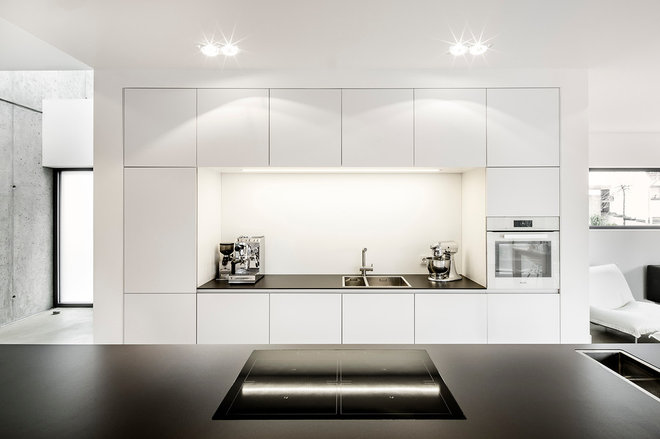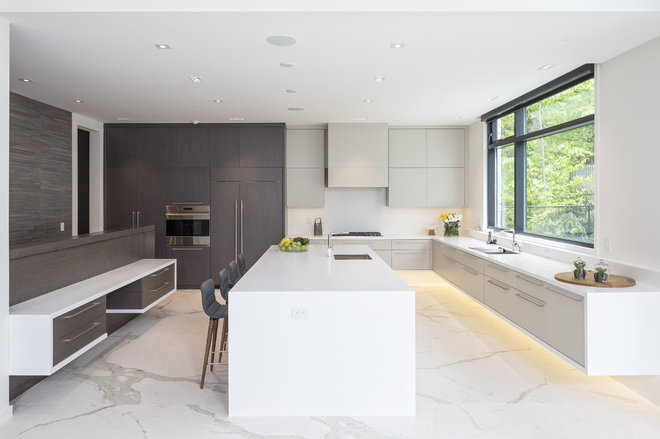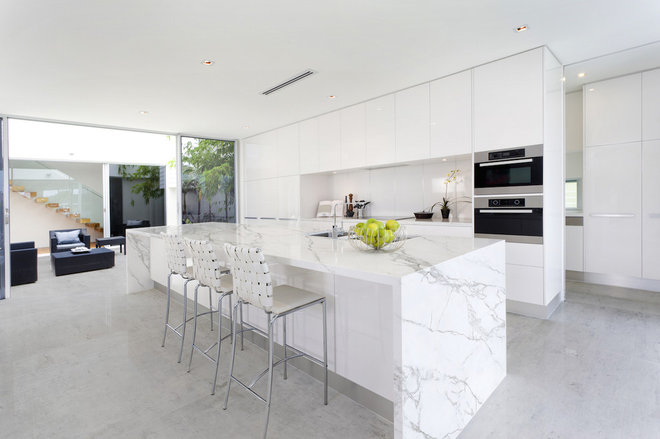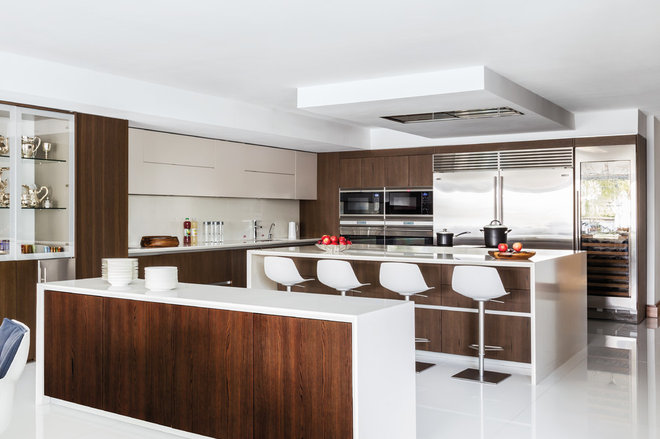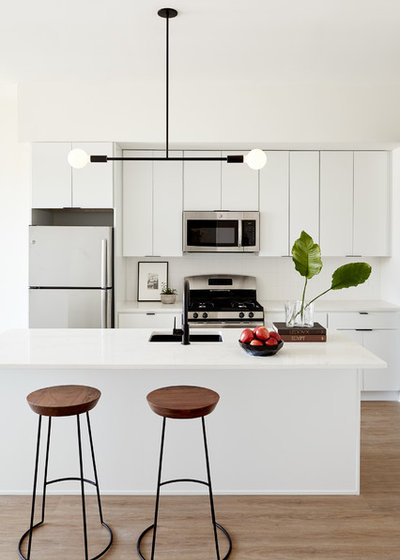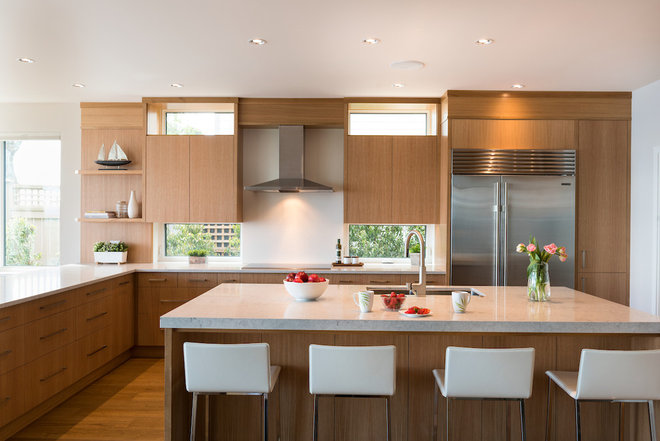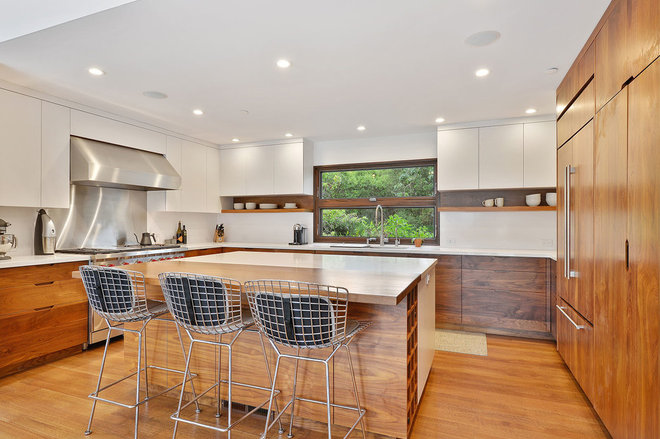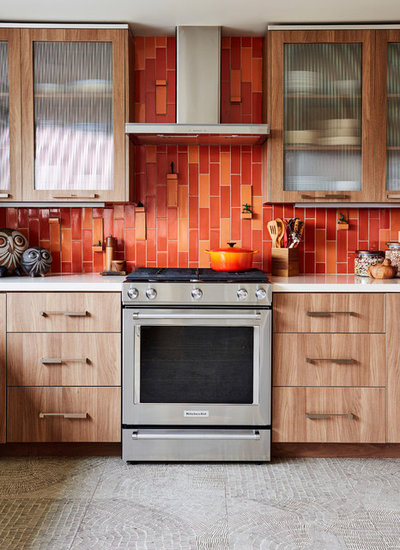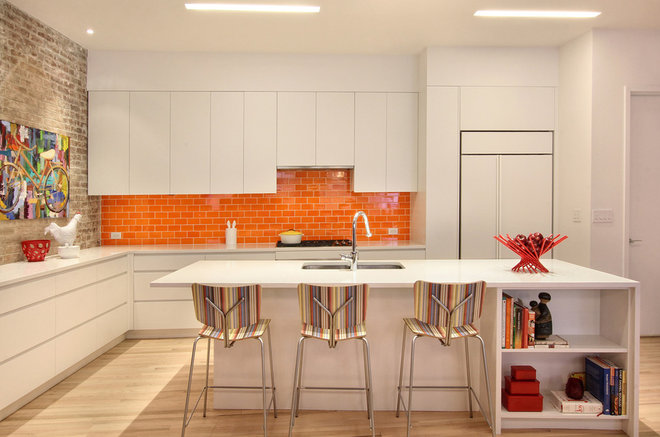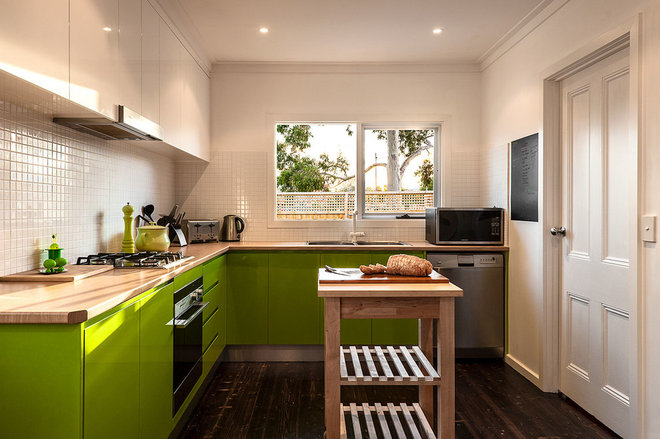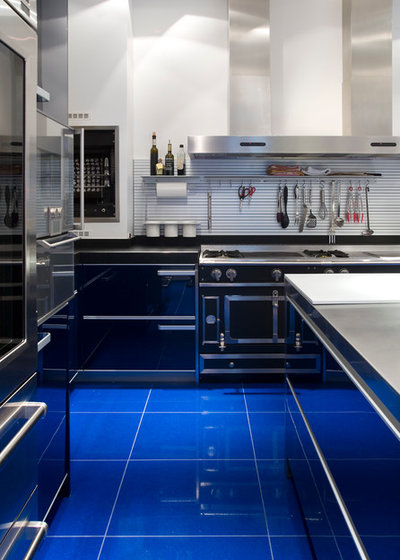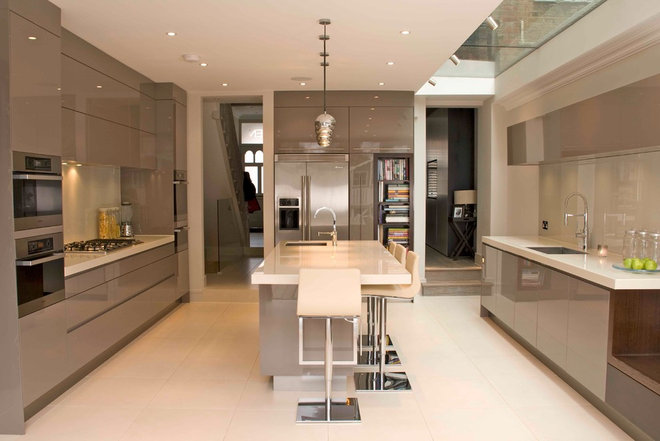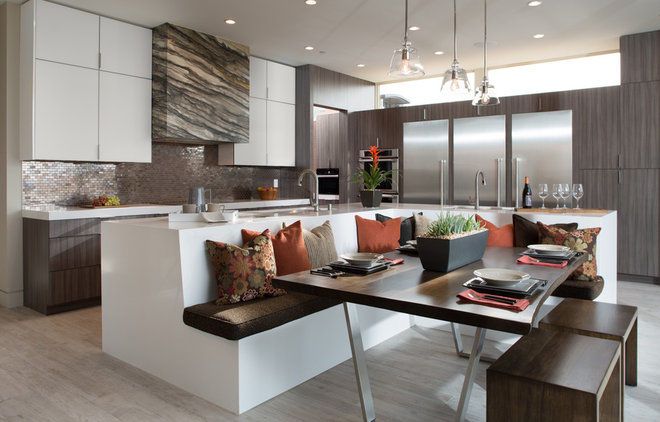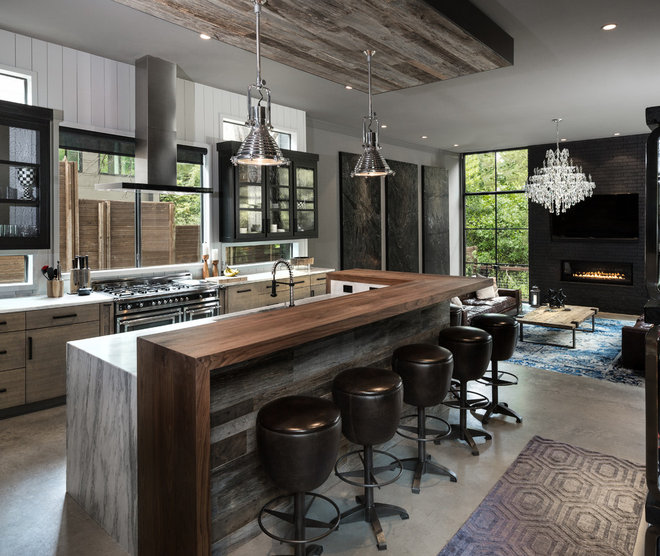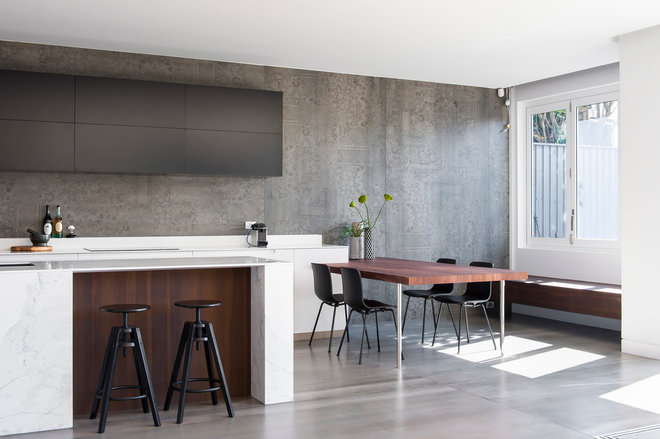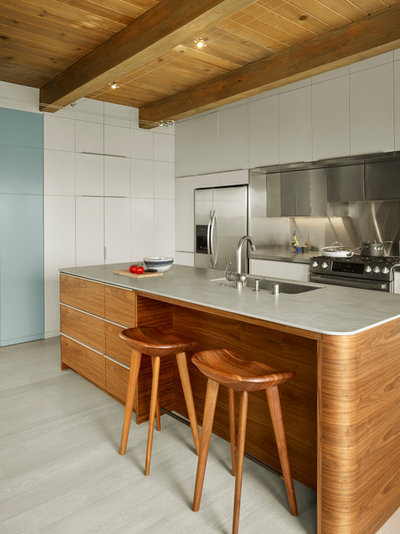“The first thing you think of in contemporary kitchens is clean lines and not a lot of adornment or overly decorative features,” says Ginger Curtis of Urbanology Designs, in Fort Worth, Texas. Color schemes can vary, but classic choices include white, cream, tan, beige, gray and black, and sometimes a mix of these colors. Palettes tend toward “slightly more monochromatic designs,” Curtis adds, while patterns tend to be more minimal or uniform. For more insight, read our guide to contemporary style.
Choose Contemporary Shapes
The secret to getting a warm contemporary kitchen is building a foundation of shapes that embodies contemporary style. From there, you can add features — in the form of color or material — that bring warmth to a kitchen. “Achieving a contemporary look that is also warm requires attention to balance, proportion and combinations of finishes, colors, textures that bring the space to life,” says Megan Padilla, senior designer at Aidan Design, in Silver Springs, Maryland. To get started, let’s look at the basic shapes and elements that set the stage.
Cabinets: “The easiest way to make a kitchen contemporary is to have a contemporary cabinet. If you have a slab door, that is a contemporary kitchen,” says Liza Riguerra of Riguerra Design in Redwood Shores, California. A slab door or drawer is flat, in one piece, without trims or frills. Often it lays over the cabinet, as in this photo, but sometimes it is set into the cabinet frame (see next photo) in a construction method known as inset. In terms of colors and finishes, these cabinets may be white and glossy, as shown here, or matte and flat, and made from wood or a variety of laminates. Many finishes can work.
Note: Some people also characterize Shaker-style doors as an option for contemporary kitchens, but all the designers I spoke with for this story said that style was a better fit for transitional or traditional kitchens.
In this photo, the slab doors are done with an inset construction. If you compare their style to the previous photo, you’ll notice that the frame, or edge, of the cabinet box is visible — that’s how you know it’s an inset construction. By contrast, the cabinet doors in the previous photo fully cover the cabinet boxes so that you see just the slab fronts.
Cabinet pulls: Contemporary kitchens often lack cabinet knobs or pulls, as in the first photo in this story. Designers can use press-touch technology or channel pulls to maintain a clean look without adding hardware. Or simple streamlined bar pulls can work in harmony with the other crisp elements of the kitchen. “If you want a decorative look, you can get stainless steel or matte black,” says Hellen Hsieh of Design Loft Co., in Palo Alto, California. “Not too fussy.” You also might see white or chrome pulls.
Horizontal orientation makes for a contemporary look and allows for uniformity, whether the cabinet opens to the left or the right, says Michael Rasky of Los Angeles-based Modern Nest. Oversizing also creates a contemporary look. “Eight to 12 inches feels a little more modern than 4 to 5 inches,” Rasky says.
Island: A popular look in contemporary kitchens is an island with a waterfall edge, which is when the counter material continues along the short edge of the island, like a waterfall tumbling off a cliff. This photo is a good example.
Flooring: Concrete, or materials that look like concrete, as shown in this photo, is excellent for a contemporary kitchen, but there are many floor types that can work. The key is not looking rustic (like knotty or rough wood grains) or heavily patterned or vintage (like Spanish or Moroccan tiles). Pattern in contemporary floors tends to be subtle or nonexistent. Oversize tile in concrete or porcelain can work, as can hardwoods.
Countertops and backsplash: In contemporary kitchens, the countertops and backsplash are frequently made of the same material, which is often a manmade option such as engineered quartz or solid surface. Watch out for too much pattern in a natural material, as it could pull the kitchen into a different design direction. For instance, “most granite cannot be very contemporary feeling,” Rasky says.
As for the countertop finish, “you’re going to see two things: shiny or matte — and less of an in-between,” Curtis says.
The backsplash doesn’t always have to be the same as the countertop, though. “There are so many options for materials,” Riguerra says. Glass tiles with clean lines can make for a contemporary look, as can more contemporary ceramic tiles or even a stone if it is “more uniform-looking,” she says.
Appliances and fixtures: Range hoods as well as appliances tend to be sleek with minimal lines. Faucets tend to be clean and sleek, often in stainless steel or matte black.
Flooring: Beton, Fusion collection, Neolith
Warm Up Those Cool Lines
Option 1: Introduce wood for organic warmth. Once you’ve planned the basic shapes for your contemporary kitchen, you might consider warming up your kitchen by introducing wood. Notice how this photo has a strikingly different feel from the first three kitchens, thanks to the wood used on the two islands and many of the cabinets.
You can choose from a variety of colors and types of wood, since all wood is considered inherently warm, but you’ll want to select a cut of the grain that doesn’t look too rustic. “Nothing knotty, like a pine,” Curtis says. Wood with straight grain lines can work well in a contemporary kitchen.
“A nice material is quarter-sawn oak. It’s cut in such a way that the lines are very clean,” Riguerra says. “The [grain] lines look very vertical, and as a result, it looks very contemporary, very clean.” Rift-cut wood is another choice for contemporary kitchens.
If you prefer to keep your cabinets and island a color and not use wood, an alternative way to warm up your kitchen is to select a wood floor. After all, the second biggest feature in the kitchen, after the cabinets, is probably the floor.
For example, this Philadelphia kitchen has a largely white palette, with white cabinets, quartz countertops and ceramic tile backsplash. But the wood floor and bar stools bring warmth into the space.
Cabinetry: Milan in Latte, Cubitac; flooring: Highlands Oak 50LVP615, COREtec Plus XL, USFloors; backsplash tile: matte Arctic White, Rittenhouse collection, Daltile; countertops: Q quartz in Carrara Marmi, M S International
Here’s another example from Portola Valley, California, where the designer mixed a few wood tones. The wood in this kitchen does show more grain than we’ve talked about as typical for a contemporary kitchen. Notice how the rougher, more reclaimed look of the shelves and back cabinet wall, as well as the back of the island, push the countertop in a more organic direction.
Option 2: Bring warmth through color. This Los Angeles kitchen, one of Rasky’s designs, benefits not only from the warmth of walnut — note the vertical grain — but also from the warm colors in the tile backsplash. Oranges, reds and golds are considered the warmer colors on the color wheel, and this room shows how they can be deployed to warm up a space.
If you want your kitchen to feel a bit more personal, you could choose an accent color for the wall paint or the backsplash, as in this apartment in the Tribeca neighborhood of New York. “You could go bold with an orange wall,” Hsieh says. “Or a bright lime-green wall — something to give it a pop.” Just be sure that whatever accent color you choose has warm undertones.
Cabinetry: custom; flooring: original oak; backsplash tile: Waterworks; refrigerator: Sub-Zero; faucet: Talis S collection, Hansgrohe; countertops: Zodiaq in Cloud White, Dupont
This photo from a Paris apartment illustrates the point. As in the previous photo, the elements in this kitchen are contemporary: slab-front cabinets, manmade flooring, horizontal bar pulls. It took seven applications of lacquer to get the shiny, very dark blue of the lower cabinets, says Florian Bochard of Atelier FB, who designed this kitchen.
Notice that the introduction of glossy cobalt blue has the opposite effect of the oranges and reds in the prior photos, keeping the temperature in this kitchen decidedly cooler. It’s a beautiful look for those drawn to the cooler tones.
Floor tiles: Bisazza; cabinetry: Schiffin; countertops: stainless steel with two Corian chopping boards; range: Grand Papa 135, La Cornue; wall rotisserie: Flamberge, La Cornue; refrigerator, freezer and wine refrigerator: Sub-Zero
Option 3: Add texture. Another way to add warmth and richness to a kitchen space is through the use of textured materials. In this kitchen in Sacramento, California, a mix of textures within an overall neutral palette — the vertical grain of the veneer on the cabinets, the shimmer of the backsplash, the organic drama of the range hood — helps soften the space and make it feel more inviting.
Rust-colored throw pillows in the dining area also raise the room’s temperature. “You can mix a white laminate and another that is more of a grayish tone with texture,” Hsieh says. “That’s the beauty of laminate: You can get these textures you can’t get with wood.”
Cabinetry: slab doors in textured laminate and glass, Ultracraft; countertops: Zodiaq in Snow White, Dupont; appliances: Thermador; porcelain floor tile: Season Wood in Winter Spruce, Daltile; backsplash: Urban Metals collection, Daltile; lighting: Progress Lighting; range hood: custom
“We like a tone-on-tone look with lots of texture,” Padilla says. “That may be achieved with a rift-cut veneer for the cabinets and chunky salvaged-wood floating shelves in a wood stain. Textural countertops with a leathered or matte finish get layered on, and the lighting and hardware are used to add eye-catching elements.”
The kitchen pictured here was the most popular new kitchen photo uploaded to Houzz between April and June 2017, and the designer (who is also the homeowner), Chris Dauwe of Dallas-based Rosewood Custom Builders, describes it as contemporary with “an industrial twist.” The kitchen is a good example of how to warm up contemporary shapes — waterfall countertops, slab cabinetry, neutral color scheme — through the use of textured materials.
Dauwe’s kitchen gets warmth via the walnut waterfall counter and the rift-cut white oak in the lower cabinetry. And the texture of the barn wood that clads the back of the island and the ceiling feature further warms the space, as does the organic material of the leather bar stools.
Marble on island and kitchen countertops: Mountain White, Vermont Quarries; leather stools: Halo Styles; paint on cabinets: Black Magic, Sherwin-Williams; pendant lights: Maritime, Restoration Hardware; range: Bertazzoni; hood: Wolf; refrigerator: Electrolux
Option 4: Create depth in your design. This is a more advanced strategy, and one you might want to get a kitchen designer to help you with. Basically the idea is that the design details themselves can give your kitchen warmth. “Warmth is not always a color thing; it’s also about the depth of a design,” Rasky says. For example, “if you were to take something like a bright white kitchen, and use tile or stone for the backsplash and countertops, and have depth.”
This kitchen is one example of the ideas Rasky is talking about. Here, design firm Minosaused large-format tiles to give the back wall texture, interest and a range of colors. Wood warms up the kitchen, yes, but so does the interplay between the patterns of the large-format wall tile, the subtly variegated flooring and the vertical grain of the wood on the island.
Wall tiles: Iris Ceramica
With a white counter, choosing a material that contains glass or resin in its mix can help the countertop bounce around light, Rasky suggests. Or, you could choose a white with a subtle pattern, as shown in this photo, to keep the countertop from feeling flat. “When things are monochromatic, it can feel very cold and a little flat and a little dead,” Rasky says. “Something that’s not completely solid, but has different variations, gives more depth.”
The kitchen with orange and red backsplash tile shown in this story (the eighth photo) also illustrates how design details can warm up a space. Notice that from the ceiling, Rasky alternated the starting point for the run of tile by thirds. More typically, it’s by halves.
This kitchen clearly benefits from the warmth of reds and oranges, but the tile-spacing strategy also could be used to warm up a kitchen in neutral tones. “The eye is moving in a random way, as opposed to looking like a Starbucks,” Rasky says. The same concept could help a contemporary kitchen feel less cool.
via Houzz http://ift.tt/2eOtpPm

